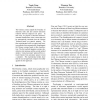Free Online Productivity Tools
i2Speak
i2Symbol
i2OCR
iTex2Img
iWeb2Print
iWeb2Shot
i2Type
iPdf2Split
iPdf2Merge
i2Bopomofo
i2Arabic
i2Style
i2Image
i2PDF
iLatex2Rtf
Sci2ools
ACL
2012
2012
Chinese Comma Disambiguation for Discourse Analysis
The Chinese comma signals the boundary of discourse units and also anchors discourse relations between adjacent text spans. In this work, we propose a discourse structureoriented classification of the comma that can be automatically extracted from the Chinese Treebank based on syntactic patterns. We then experimented with two supervised learning methods that automatically disambiguate the Chinese comma based on this classification. The first method integrates comma classification into parsing, and the second method adopts a “post-processing” approach that extracts features from automatic parses to train a classifier. The experimental results show that the second approach compares favorably against the first approach.
ACL 2012 | Chinese Treebank | Computational Linguistics | Discourse Relations | Syntactic Patterns |
| Added | 29 Sep 2012 |
| Updated | 29 Sep 2012 |
| Type | Journal |
| Year | 2012 |
| Where | ACL |
| Authors | Yaqin Yang, Nianwen Xue |
Comments (0)

